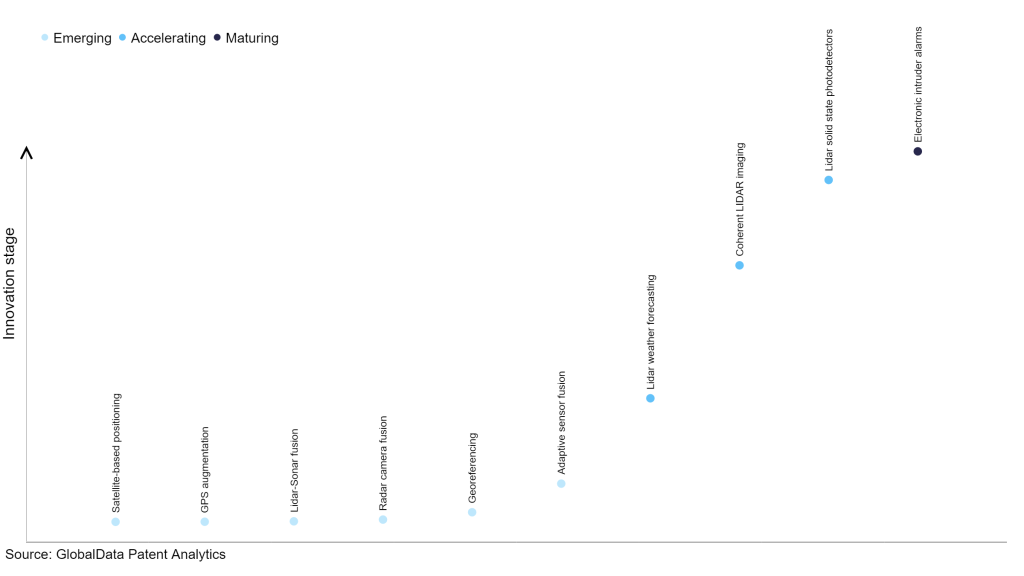The aerospace and defense industry continues to be a hotbed of patent innovation. Activity is driven by the pressing need for modernization, and the growing importance of technologies such as artificial intelligence (AI), Internet of Things (IoT), and unmanned systems. In the last three years alone, there have been over 237,000 patents filed and granted in the aerospace and defense industry, according to GlobalData’s report on Internet of Things in defense: LiDAR solid state photodetectors. Buy the report here.
However, not all innovations are equal and nor do they follow a constant upward trend. Instead, their evolution takes the form of an S-shaped curve that reflects their typical lifecycle from early emergence to accelerating adoption, before finally stabilizing and reaching maturity.
Identifying where a particular innovation is on this journey, especially those that are in the emerging and accelerating stages, is essential for understanding their current level of adoption and the likely future trajectory and impact they will have.
110 innovations will shape the aerospace and defense industry
According to GlobalData’s Technology Foresights, which plots the S-curve for the aerospace and defense industry using innovation intensity models built on over 206,000 patents, there are 110 innovation areas that will shape the future of the industry.
Within the emerging innovation stage, satellite-based positioning, GPS augmentation, and LiDAR-sonar fusion are disruptive technologies that are in the early stages of application and should be tracked closely. LiDAR weather forecasting, coherent LiDAR imaging, and LiDAR solid state photodetectors are some of the accelerating innovation areas, where adoption has been steadily increasing.
Innovation S-curve for Internet of Things in the aerospace and defense industry

LiDAR solid state photodetectors is a key innovation area in Internet of Things
Light detection and ranging (LiDAR) is a remote sensing method that uses light in the form of a pulsed laser to measure distances. A photodetector is an electronic component that absorbs light energy and generates a proportional electric current or voltage. In LiDAR systems, solid-state photodetectors are used to detect the returning laser light and measure the distance of objects.
GlobalData’s analysis also uncovers the companies at the forefront of each innovation area and assesses the potential reach and impact of their patenting activity across different applications and geographies. According to GlobalData, there are 50+ companies, spanning technology vendors, established aerospace and defense companies, and up-and-coming start-ups engaged in the development and application of LiDAR solid state photodetectors.
Key players in LiDAR solid state photodetectors – a disruptive innovation in the aerospace and defense industry
‘Application diversity’ measures the number of applications identified for each patent. It broadly splits companies into either ‘niche’ or ‘diversified’ innovators.
‘Geographic reach’ refers to the number of countries each patent is registered in. It reflects the breadth of geographic application intended, ranging from ‘global’ to ‘local’.
Patent volumes related to LiDAR solid state photodetectors
Source: GlobalData Patent Analytics
Hamamatsu Photonics is one of the leading patent filers in LiDAR solid state photodetectors. It was recently granted a patent for a distance sensor that can measure a distance to an object by repeatedly irradiating light to an object and detecting reflected light from the object. The semiconductor substrate of the sensor includes a photosensitive region to generate charges corresponding to the amount of the reflected light. Charges from the photosensitive region are collected in separate charge collection regions, and the distance to the object is measured based on the difference in charge amount between the storage nodes.
The company offers a range of photodetector products, including silicon avalanche photodiodes (APD), silicon positive-intrinsic-negative (PIN) and indium gallium arsenide (InGaAs) photodiodes, and near-infrared, high-sensitivity surface-mount multipixel photon counters (MPPC) for time-of-flight (TOF) and frequency-modulated continuous-wave (FMCW) LiDAR systems.
Some other key patent filers in this space include Samsung, Aeluma, and Toshiba.
In terms of application diversity, Nikon, TriEye, and Shenzhen Goodix Technology are some of the leading innovators. By means of geographic reach, some of the leading patent filers include Alphabet, Apple, and Semiconductor Energy Laboratory.
To further understand the key themes and technologies disrupting the aerospace and defense industry, access GlobalData’s latest thematic research report on Aerospace & Defense.
Data Insights
From

The gold standard of business intelligence.
Blending expert knowledge with cutting-edge technology, GlobalData’s unrivalled proprietary data will enable you to decode what’s happening in your market. You can make better informed decisions and gain a future-proof advantage over your competitors.







